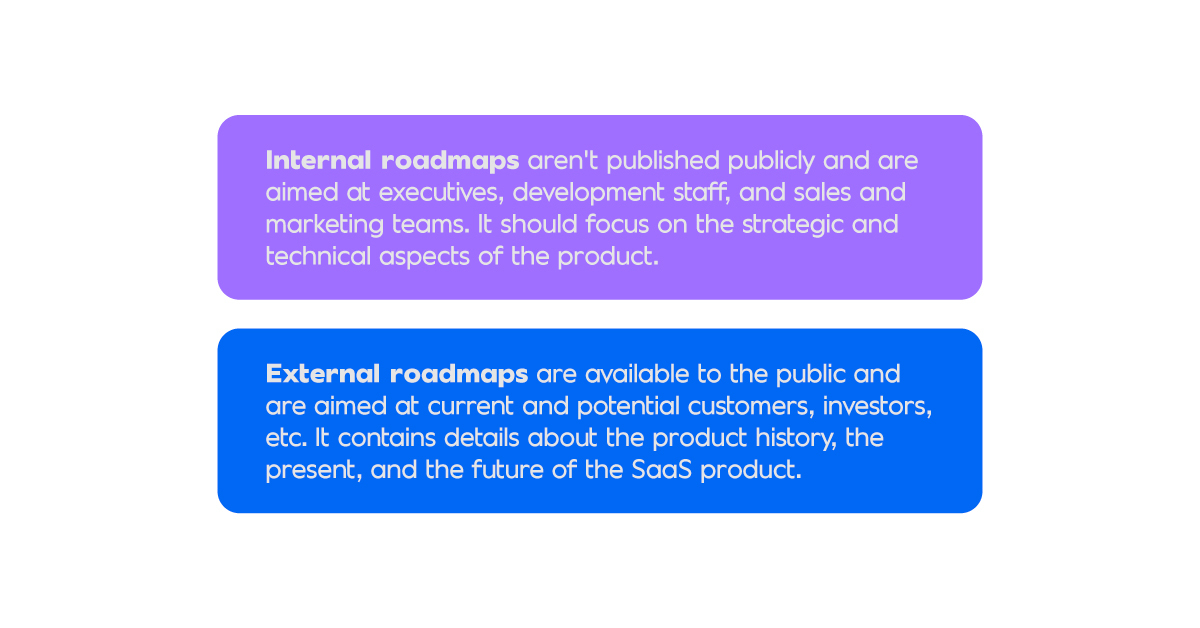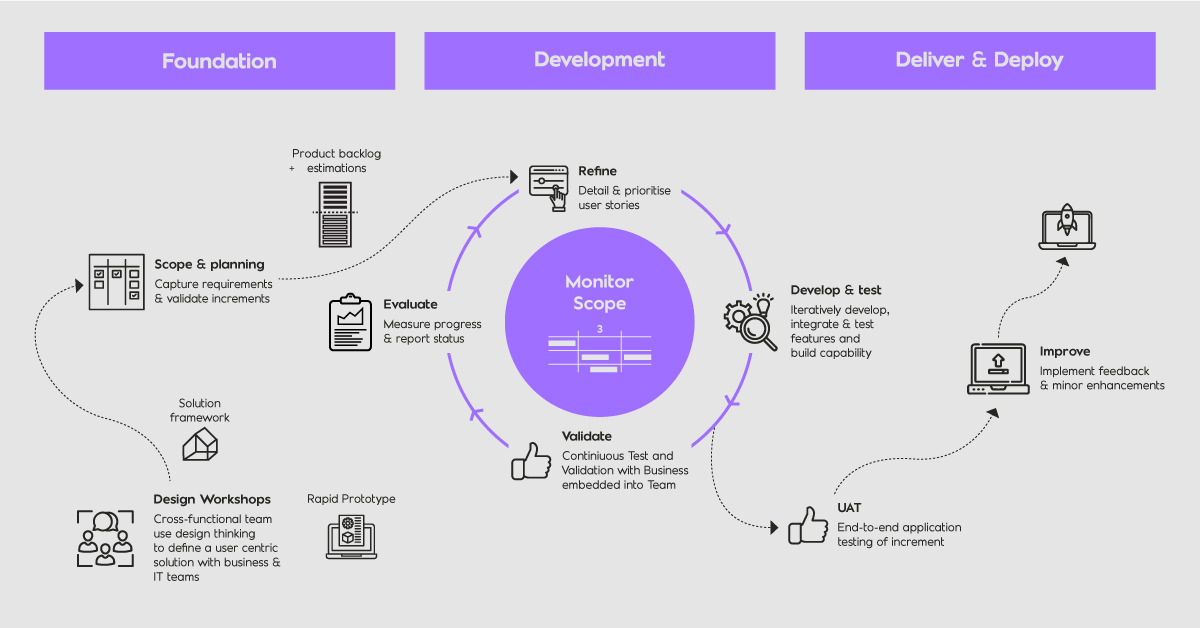Developing your software as a service (SaaS) from a prototype to a scalable solution is a complex process that requires accurate planning and definition of the right goals. Of around 3,000 new products launched each year, only 15% are truly successful, and according to Statista, that 15% has probably now dropped again. To increase your SaaS product's chances of success, you need to carefully plan your product's path from conception to launch. In other words, you need to create a SaaS product roadmap. By clearly envisioning the future of your product, you can engage stakeholders, empower your development team, and keep everyone focused on a common vision.
In this blog post, we'll break down the key elements of a SaaS product roadmap and provide practical advice on how you can create a roadmap that leads to success.
The Purpose of a SaaS Product Roadmap
The SaaS product roadmap is a kind of compass for the entire development process that aligns the product strategy with the business objectives and customer needs. It's a long-term product vision with all the steps needed to achieve it, priorities, and the state of affairs in this regard. Since SaaS products usually involve many changes, migrations, and updates, this roadmap helps all stakeholders, external and internal experts, to stay informed, track changes, and communicate easily.
Therefore, the Saas product roadmap isn't a static document created in the beginning but dynamic and live. So, your roadmap changes with new updates and constantly reflects the hard work your team puts into the product.
The main purpose of a SaaS product roadmap is to:
- Give a clear action plan with market positioning and key milestones,
- Effectively allocate resources,
- Provide accurate timelines for each phase of product development,
- Increase transparency and keep everyone involved in the process informed,
- Identify and prioritize desired and planned features,
- Show progress current and expected.
Who Uses the SaaS Product Roadmap?
Since every SaaS product is different and many parties are involved, there is no one roadmap that fits all. Often companies need to create two or more product roadmaps to accommodate different audiences. For example, the development team, including software engineers, designers, and QA testers, needs more technical information, while executives and stakeholders are more focused on business opportunities and have no need for technical details.
Roadmaps for customers, on the other hand, should focus on the product features and benefits that will be improved. So, a good product roadmap should involve all internal and external stakeholders, and in this case, there are two main types:

Steps to Create a Roadmap for the SaaS Product
The SaaS product roadmap should help structure and communicate product strategy, milestones, and timelines. These elements provide clarity, alignment, and focus throughout the product development process so that all stakeholders know at all times what the product team is doing, why it's doing it, and how it'll impact the SaaS solution.
Whether you are starting from scratch or improving your existing roadmap, there are several steps you should take in order to create a productive and effective SaaS product roadmap.
Foundations: Design and Brainstorming
What can be defined as ‘phase zero’ of a project is a design workshop. Cross-functional teams utilize design thinking to create a user-centric solution. During this phase, both the client and the SaaS provider give their ideas and suggestions and reach the best solution possible.
Step 1: Scope Planning - Vision, Strategy, and Goals
The initial step in creating your SaaS product roadmap is to capture requirements and validate increments. Be clear about what you want to achieve with your SaaS product. Defining your product vision, strategy, and goals should be the foundation for the roadmap and should drive the development and direction of your SaaS product. This step in creating the roadmap should provide answers to the following questions:
- What problem will your product solve?
- What unique value does your product provide?
- Who is your ideal customer?
- What are your long-term and short-term goals?
Step 2: Collecting Input from All Involved Parties
After you've envisioned your SaaS product, it's time to create an execution plan. To accomplish this, you should seek input from all parties involved in the development process. This way, you can gather valuable insights, align perspectives, and ensure that the roadmap reflects the shared vision and goals. A good method is to hold brainstorming sessions or workshops to foster collaboration and gather their input. For example, your product team has valuable expertise and technical knowledge. The sales and marketing teams know market dynamics, customer feedback, customer pain points, and feature requests.
By engaging all relevant stakeholders and gathering their input, you foster a sense of ownership, collaboration, and shared vision, resulting in an effective SaaS product roadmap.
Step 3: Refining the Plan
After you've gathered input from various parties, the next step in creating a SaaS product roadmap is to refine the plan by prioritizing and sorting out the essential requirements. Carefully review all the input you received from various stakeholders, such as the product team, executives, sales and marketing teams, customer support, and customers. Identify common themes, patterns, and recurring desires. Look for ideas that are critical to the success of your product and align with the core value proposition, such as your product vision, strategy, and goals.
Step 4: Set a Time Frame and Allocate Resources
The next step is to set a realistic timeline for development, manage resource availability, and ensure smooth execution.
Review the capacity of your team, including developers, designers, QA testers, and any other necessary roles. If you need additional resources, you can consider experienced external experts to complement your team and help you meet the roadmap goals.
Once you have allocated resources, divide the development process into meaningful phases with clear deliverables for each phase. Consider phases such as feature development, testing, integration, and release cycles. Work with your development team to estimate the time required for each phase. Consider the complexity of tasks, dependencies, and potential risks or challenges.
In order to make this phase successful, the Valcon development team works according to agile methodologies that include shorter iterations or sprints. The Valcon team and the client regularly work in sprints that map the features or tasks to be completed within each sprint. This allows for flexibility and adaptability as priorities and requirements may change over time.
Step 5: Development & Testing
Once everything is ready and planned out, the development phase can begin. This is done iteratively, as new features are being integrated and capabilities built. Each new feature added to the platform is tested to ensure everything runs smoothly.
Step 6: Validation
Continuous testing and validation are crucial to the success of any project. Because of that, the validation phase is done by the development and QA teams, who are in constant contact with the client, ensuring satisfaction.
Step 7: Evaluate and Refine Again
As mentioned earlier, the SaaS product roadmap isn't a static document, but a living guide that should evolve and adapt as your product and the market landscape change. To ensure its effectiveness, it's important that you update your roadmap regularly. Continuously monitor key performance indicators and measure progress at each stage of development and use this data to update your roadmap and prioritize features accordingly. Also, don't forget to keep a close eye on industry trends, market changes, and new technologies. By staying current, you'll ensure that your product remains relevant and competitive.
The status is then reported back to the client, after which the whole project can undergo further refinement.
Step 8: UAT and Improvements
Before launching, it’s crucial to conduct end-to-end application testing of increments. UAT, or user acceptance testing, allows insight into valuable feedback based on which further improvements are made. After implementing them and completing minor enhancements, the platform is ready to hit the market!

Getting Started Developing Your SaaS Product with Valcon
Be unique in your business. Valcon offers expert cloud engineering services, with great experience in developing high-quality, customized, and unique software that supports your processes and grows your business. In all our projects, we analyze your business and create detailed, agile, and flexible roadmaps to ensure they grow along with your business. Visit our website to learn more about our services.


